Modeling of Quantitative Characterization Parameters and Identification of Fluid Properties in Tight Sandstone Reservoirs of the Ordos Basin
Abstract
1. Introduction
2. Characterization of Tight Sandstone Reservoirs
2.1. Lithological Characteristics
2.2. Physical Characteristics
2.3. Electrical Characteristics
2.4. Oil-Bearing Characteristics
3. Research on Evaluation Methods of Logging Interpretation
3.1. Calculation of Shale Content
3.2. Calculation of Porosity
3.3. Calculation of Permeability
3.4. Calculation of Oil Saturation
3.4.1. Porosity Classification Method for Calculating Oil Saturation
3.4.2. Calculation of Oil Saturation by Acoustic Time Difference Logging
4. Fluid Property Identification
5. Examples of Logging Interpretation Model Applications
6. Conclusions
- (1)
- The investigation of the evaluation method for tight sandstone reservoirs in the lower assemblage of the south-central Ordos involves the exploration of the interrelationships among the “four properties”. Based on this research, specialized models focusing on parameters such as the shale content, porosity, permeability, and saturation degree of tight sandstone reservoirs are developed or selected. These models demonstrate effective applicability to tight sandstones.
- (2)
- For the problem of high shale content in tight sandstone reservoirs, GR and AC (SP and AC) are used to calculate the shale index, and the weighting method is effective.
- (3)
- The established porosity classification method and acoustic time difference method for calculating oil saturation in tight sandstone reservoirs overcame the difficulty of resistivity reflecting the weakening of oil bearing and improved the accuracy of interpretation of oil saturation in reservoirs.
- (4)
- The multi-information four-step method gradually recognizes the fluid characteristics of tight sandstone reservoirs and improves the compliance rate of log interpretation, which is applied to 20 wells in the block with a compliance rate of 95.23%, and lays the foundation for accurately establishing the interpretation standard of tight sandstone. This method is not only important for the development of tight sandstone reservoirs in the lower assemblage of the Ordos Basin but also for the identification of fluid properties of tight sandstone reservoirs in other blocks.
Author Contributions
Funding
Data Availability Statement
Conflicts of Interest
References
- Zhou, L.H.; Chen, C.W.; Han, G.M.; Yang, F. Difference characteristics between continental shale and tight oil and exploration practice: A case from Huanghua Depression, Bohai Bay Basin. Earth Sci. 2021, 46, 555–571. [Google Scholar]
- Huang, W.; Zhang, X.L.; Zhao, J.Y. Fluild Identification of Tight Reservoir in Chang 9 Formation, Ordos Basin. J. Northwest Univ. 2015, 45, 811–818. [Google Scholar]
- Wen, B.; Zhou, Y. Study on fluid identification of low porosity and low permeability reservoir. Petrochem. Ind. Technol. 2017, 24, 126. [Google Scholar]
- Albrecht, D.; Reitenbach, V. Laboratory measurements of fluid transport properties on tight gas sandstones and applications. Energy Procedia 2014, 59, 366–373. [Google Scholar] [CrossRef]
- Bi, M.W.; Chen, S.Y.; Zhou, Z.H. Genesis of secondary pores of tight sandstone reservoir in He 8th Member in Su 6 area of Sulige gas field. J. China Univ. Petrol. 2015, 39, 8–16. [Google Scholar]
- Guo, J.; Ling, Z.; Xu, X.; Zhao, Y.; Yang, C.; Wei, B.; Zhang, Z.; Zhang, C.; Tang, X.; Chen, T.; et al. Saturation Determination and Fluid Identification in Carbonate Rocks Based on Well Logging Data: A Middle Eastern Case Study. Processes 2023, 11, 1282. [Google Scholar] [CrossRef]
- Bi, L.R.; Mao, Z.Q.; Xiao, C.W.; Liu, X.L. Application of normal distribution method in identifying oil (gas) and water zones. J. Oil Gas Technol. 2006, 28, 76–78. [Google Scholar]
- Cheng, X.Z.; Zhou, C.C.; Fan, Y.R.; Wang, Z.H.; Huang, S.X. Genesis and identification of low contrast pay zones in fresh-water reservoirs. J. Oil Gas Technol. 2007, 29, 62–68. [Google Scholar]
- Li, L.; Yuan, Z.; Hui, K.; Liu, S. Accumulation regularity of Upper Paleozoic gas in north Ordos Basin. Oil Gas Geol. 2000, 21, 268–271. [Google Scholar]
- He, X.; Chen, S.; Hu, C.; Zhang, H.; Mou, F.; Dai, L.; Lu, Y.; Fu, X.; Han, M. Pore Structure Change in the Continental Shale Oil Reservoir and Its Main Influencing Factors: A Case Study of the Chang 7 Member in the Ordos Basin. Processes 2023, 11, 2314. [Google Scholar] [CrossRef]
- Zhu, H.; Chen, K.; Liu, K.; He, S. A sequence stratigraphic model for reservoir sand-body distribution in the Lower Permian Shanxi Formation in the Ordos Basin, northern China. Mar. Pet. Geol. 2008, 25, 731–743. [Google Scholar] [CrossRef]
- Chen, Z.; Li, X.; Chen, H.; Duan, Z.; Qiu, Z.; Zhou, X.; Hou, Y. The Characteristics of Lithofacies and Depositional Model of Fine-Grained Sedimentary Rocks in the Ordos Basin, China. Energies 2023, 16, 2390. [Google Scholar] [CrossRef]
- Zheng, W.; Hu, X.; Chen, S.; Liu, J.; Jia, C. Characteristics of sedimentary evolution in the Upper Paleozoic Daniudi Gasfield, Ordos Basin. Acta Sedimentol. Sin. 2015, 33, 306–313. [Google Scholar]
- Mao, K.Y. Logs fluid typing methods and adaptive analysis of tight sandstone reservoir of Yingcheng formation in Lishu Fault. Adv. Earth Sci. 2016, 31, 1056–1066. [Google Scholar]
- Jamil, M.; Siddiqui, N.A.; Rahman, A.H.B.A.; Ibrahim, N.A.; Ismail, M.S.B.; Ahmed, N.; Usman, M.; Gul, Z.; Imran, Q.S. Facies Heterogeneity and Lobe Facies Multiscale Analysis of Deep-Marine Sand-Shale Complexity in the West Crocker Formation of Sabah Basin, NW Borneo. Appl. Sci. 2021, 11, 5513. [Google Scholar] [CrossRef]
- Jamil, M.; Siddiqui, N.A.; Usman, M.; Wahid, A.; Umar, M.; Ahmed, N.; Haq, I.U.; El-Ghali, M.A.K.; Imran, Q.S.; Rahman, A.H.A.; et al. Facies analysis and distribution of Late Palaeogene deep-water massive sandstones in submarine-fan lobes, NW Borneo. Geol. J. 2022, 57, 4489–4507. [Google Scholar] [CrossRef]
- Sun, J.M.; Wei, X.H.; Chen, X.L. Fluid identification in tight sandstone reservoirs based on a new rock physics model. J. Geophys. Eng. 2016, 13, 526–535. [Google Scholar] [CrossRef]
- Wang, F.; Yang, X.M.; Zhang, Y.H.; Bian, H.Y. Application of multi-algorithmic fusion methods to fluid identity in tight reservoir. Prog. Geophys. 2015, 30, 2785–2792. [Google Scholar]
- He, M.; Gu, H.M.; Wan, H. Log interpretation for lithology and fluid identification using deep neural network combined with MAHAKIL in a tight sandstone reservoir. J. Pet. Sci. Eng. 2020, 194, 107498. [Google Scholar] [CrossRef]
- Li, H.; Tang, H.M.; Qin, Q.R.; Zhou, J.L.; Qin, Z.J.; Fan, C.H.; Su, P.; Wang, Q.; Zhong, C. Characteristics, formation periods and genetic mechanisms of tectonic fractures in the tight gas sandstones reservoir: A case study of xujiahe formation in YB area, sichuan basin, China. J. Pet. Sci. Eng. 2019, 178, 723–735. [Google Scholar] [CrossRef]
- Li, B.; Tan, M.J.; Zhang, H.T. Interpretation method of nuclear magnetic resonance dual-TW logging in oil-wet tight sandstone reservoirs. Appl. Geophys. 2020, 5, 796–808. [Google Scholar] [CrossRef]
- Chen, J.; Xie, R.C.; Liu, C.C.; Duan, Y.; Li, H.; Xiang, Y. Logging fluid identification and quantitative evaluation of Jurassic tight sandstone gas reservoir in Zhongjiang gas field. Nat. Gas Ind. 2019, 39, 136–141. [Google Scholar]
- Fu, L.; Qin, Z.; Xie, A.; Chen, L.; Li, J.; Wang, N.; Qin, Q.; Mao, K. The relation of the “four properties” and fluid identification of the carboniferous weathering crust volcanic reservoir in the Shixi Oilfield, Junggar Basin, China. Front. Earth Sci. 2022, 10, 983572. [Google Scholar] [CrossRef]
- Zou, C.; Zhu, R.; Wu, S.; Yang, Z.; Tao, S.; Yuan, X. Types, characteristics, genesis and prospects of conventional and unconventional hydrocarbon accumulations: Taking tight oil and tight gas in China as an instance. Acta Pet. Sin. 2012, 33, 173–187. [Google Scholar]
- Dai, J.; Ni, Y.; Wu, X. Tight gas in China and its significance in exploration and exploitation. Pet. Explor. Dev. 2012, 39, 277–284. [Google Scholar] [CrossRef]
- Guo, X.; Liu, K.; Jia, C.; Song, Y.; Zhao, M.; Zhuo, Q.; Lu, X. Hydrocarbon accumulation processes in the Dabei tight-gas reservoirs, Kuqa Subbasin, Tarim Basin, northwest China. AAPG Bull. 2016, 100, 1501–1521. [Google Scholar] [CrossRef]
- Wu, H.; Zhao, J.; Wu, W.; Li, J.; Huang, Y.; Chen, M. Formation and diagenetic characteristics of tight sandstones in closed to semi-closed systems: Typical example from the Permian Sulige gas field. J. Pet. Sci. Eng. 2020, 199, 108248. [Google Scholar] [CrossRef]
- Shaogui, D.; Yiren, F.; Guoxin, L. Influence of formation water salinity on physical properties of argillaceous sandstone. Well Logging Technol. 2006, 30, 113–115. [Google Scholar]
- Haiyong, M.; Lifa, Z.; Xiuqin, D. Hydrochemical characteristics and geological significance of the Chang 8 formation of the Yanchang Formation in Jiyuan area, Ordos Basin. J. Northwest Univ. 2013, 43, 253–257. [Google Scholar]
- Fan, R.; Zhou, L.; Wu, J.; Zeng, T.; Zhou, X.F. Research on tight sandstone reservoir fluids identification in Xujiahe formation, northeastern Sichuan Basin. Petrol. Geol. Recov. Effic. 2015, 22, 67–71. [Google Scholar]
- Mode, A.W.; Anyiam, O.A.; Aghara, I.K. Identification and petrophysical evaluation of thinly bedded low-resistivity pay reservoir in the Niger Delta. Arab. J. Geosci. 2014, 8, 2217–2225. [Google Scholar] [CrossRef]
- Xu, Z.; Jiang, S.; Liu, L.; Wu, K.; Li, R.; Liu, Z.; Shao, M.; Jia, K.; Feng, Y. Natural gas accumulation processes of tight sandstone reservoirs in deep formations of Songliao Basin, NE China. J. Nat. Gas Sci. Eng. 2020, 83, 103610. [Google Scholar] [CrossRef]
- Wang, Q.; Chen, D.; Wang, F.; Gao, X.; Zou, Y.; Tian, Z.; Li, S.; Chang, S.; Yao, D. Origin and distribution of an under-pressured tight sandstone reservoir: The Shaximiao Formation, Central Sichuan Basin. Mar. Petrol. Geol. 2021, 132, 121–128. [Google Scholar] [CrossRef]
- Zhou, X.; Xu, G.; Cui, H.; Zhang, W. Fracture development and hydrocarbon accumulation in tight sandstone reservoirs of the Paleogene Huagang Formation in the central reversal tectonic belt of the Xihu Sag, East China Sea. Pet. Explor. Dev. 2020, 47, 499–512. [Google Scholar] [CrossRef]
- Jia, J.; Yin, W.; Qiu, N.; Wang, G.; Ma, L.; Liu, Y.; Liu, N. Migration and accumulation of crude oil in Upper Triassic tight sand reservoirs on the southwest margin of Ordos Basin, Central China: A case study of the Honghe Oilfield. Geol. J. 2017, 53, 2280–2300. [Google Scholar] [CrossRef]
- Yang, H.; Fu, J.; Wei, X.; Liu, X. Sulige field in the Ordos Basin: Geological setting, field discovery and tight gas reservoirs. Mar. Pet. Geol. 2008, 25, 387–400. [Google Scholar] [CrossRef]
- He, Y.H.; Yang, X.; Wang, X.J.; Zhong, Z.Q.; Hou, D.J. Fluid identification in low permeability reservoir in Jiyuan area, Ordos Basin. China Petrol. Explor. 2016, 21, 110–115. [Google Scholar]
- Wyllie, M.R.J.; Gregory, A.R.; Gardner, L.W. Elastic wave velocities in heterogeneous and porous media. Geo-Physics 1956, 21, 41–70. [Google Scholar] [CrossRef]
- Raymer, L.L.; Hunt, E.R.; Gardner, J.S. An improved sonic transit time-to-porosity transform. In Proceedings of the SPWLA 21st Annual Logging Symposium, Lafayette, LA, USA, 8 July 1980; SPWLA-1980-P. OnePetro: Richardson, TA, USA, 1980. [Google Scholar]
- Martin, J.P.; Nicoletis, S.; Raiga-Clemenceau, J. The concept of acoustic formation factor for more accurateporosity determination from sonic transit time data. Log Anal. 1988, 29, SPWIA-1988-v29n1a4. [Google Scholar]
- Gao, J.; Ma, B.; Lu, Y.; Zhang, W.; Cao, Q. Origin of authigenic kaolinite with implications for Permian tight gas sandstone reservoirs in the northern Ordos Basin, central China. J. Nat. Gas Sci. Eng. 2022, 99, 104429. [Google Scholar] [CrossRef]
- Wang, G.; Chang, X.; Yin, W.; Li, Y.; Song, T. Impact of diagenesis on reservoir quality and heterogeneity of the Upper Triassic Chang 8 tight oil sandstones in the Zhenjing area, Ordos Basin, China. Mar. Pet. Geol. 2017, 83, 84–96. [Google Scholar] [CrossRef]
- Zhao, G.P. Characterization of fluid inclusions and timing of gas accumulation in Upper Paleozoic reservoirs of Hangjinqi area, Ordos Basin. Oil Gas Geol. 2017, 38, 905–912. [Google Scholar]
- Archie, G.E. The electrical resistivity log as an aid in determining some reservoir characteristics. Trans. Am. 1942, 146, 41–56. [Google Scholar] [CrossRef]
- Liu, Y.; Ye, J.; Zong, J.; Wang, D.; Cao, Q.; Yang, B.; Li, W.; Zhao, J. Analysis of forces during tight oil charging and implications for the oiliness of the tight reservoir: A case study of the third member of the Palaeogene Shahejie Formation, Qibei slope, Qikou sag. Mar. Pet. Geol. 2022, 144, 105819. [Google Scholar] [CrossRef]
- He, Y.; Guo, H.; Lan, H.; Ling, C.; Fu, M. The Effect of Single Sandstone Stacking Pattern on the Sandstone Reservoir Physical Properties—A Case Study from the Shanxi Formation in the Daniudi Area, Northeastern Ordos Basin. Energies 2022, 15, 4740. [Google Scholar] [CrossRef]
- Zhao, G.; Li, X.; Liu, M.; Dong, C.; Chen, D.; Zhang, J. Reservoir Characteristics of Tight Sandstone and Sweet Spot Prediction of Dibei Gas Field in Eastern Kuqa Depression, Northwest China. Energies 2022, 15, 3135. [Google Scholar] [CrossRef]
- Wang, R.; Sun, W. A Study on Micro Cracks in Super Low Permeability Sandstone Reservoir of the Upper Triassic Yanchang Formation in the Ordos Basin. Geol. Rev. 2009, 55, 444–448. [Google Scholar]
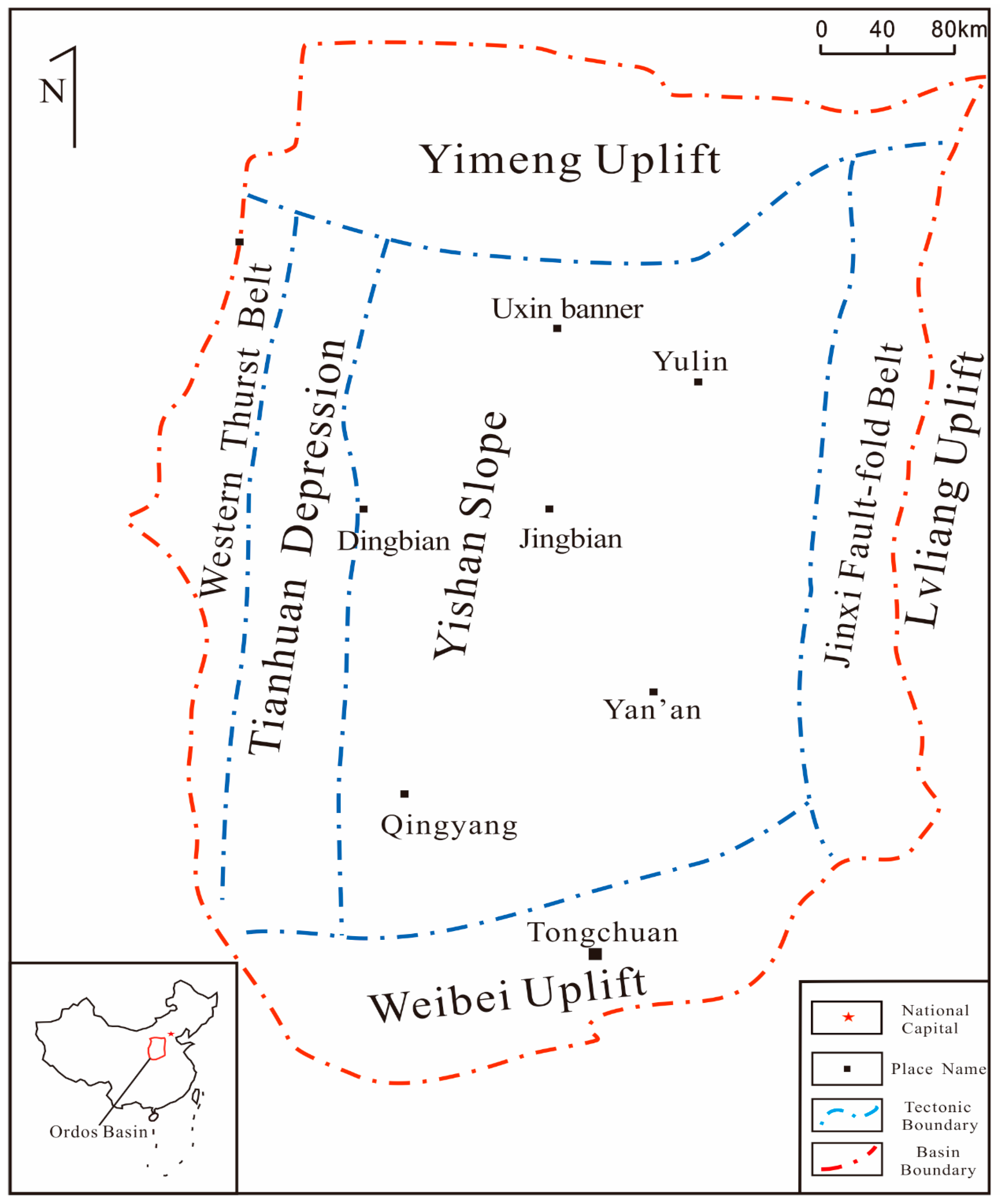


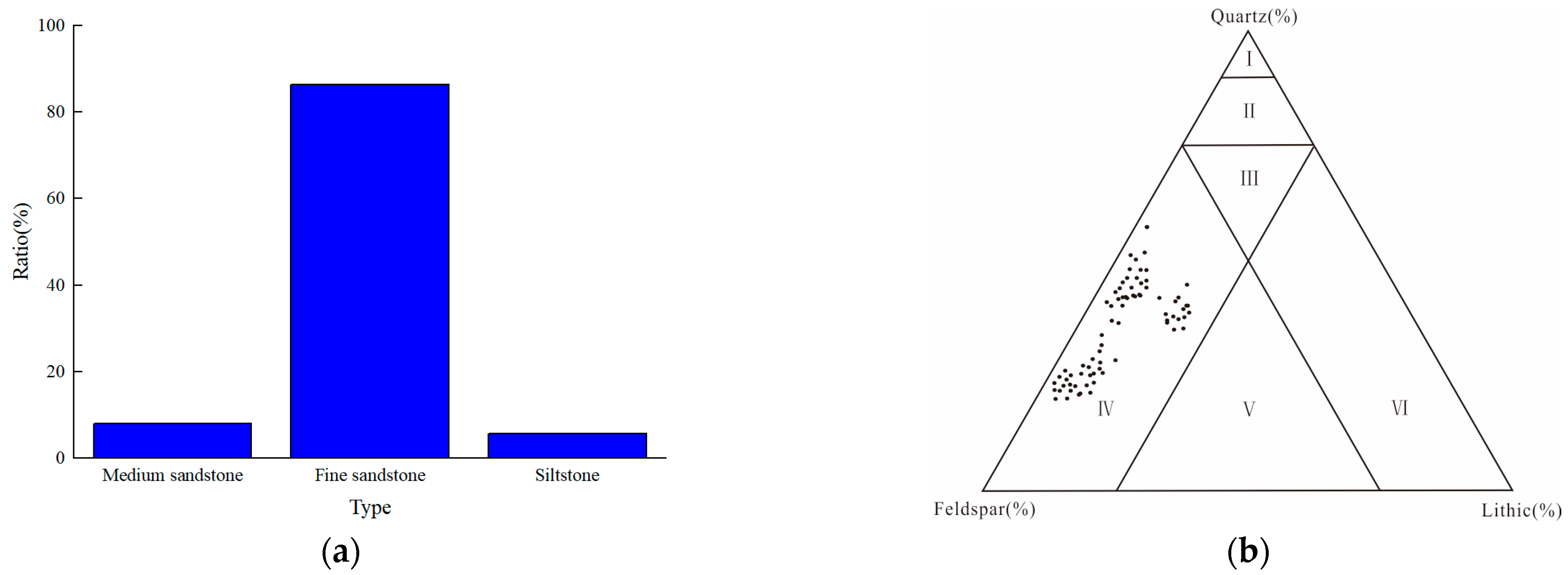
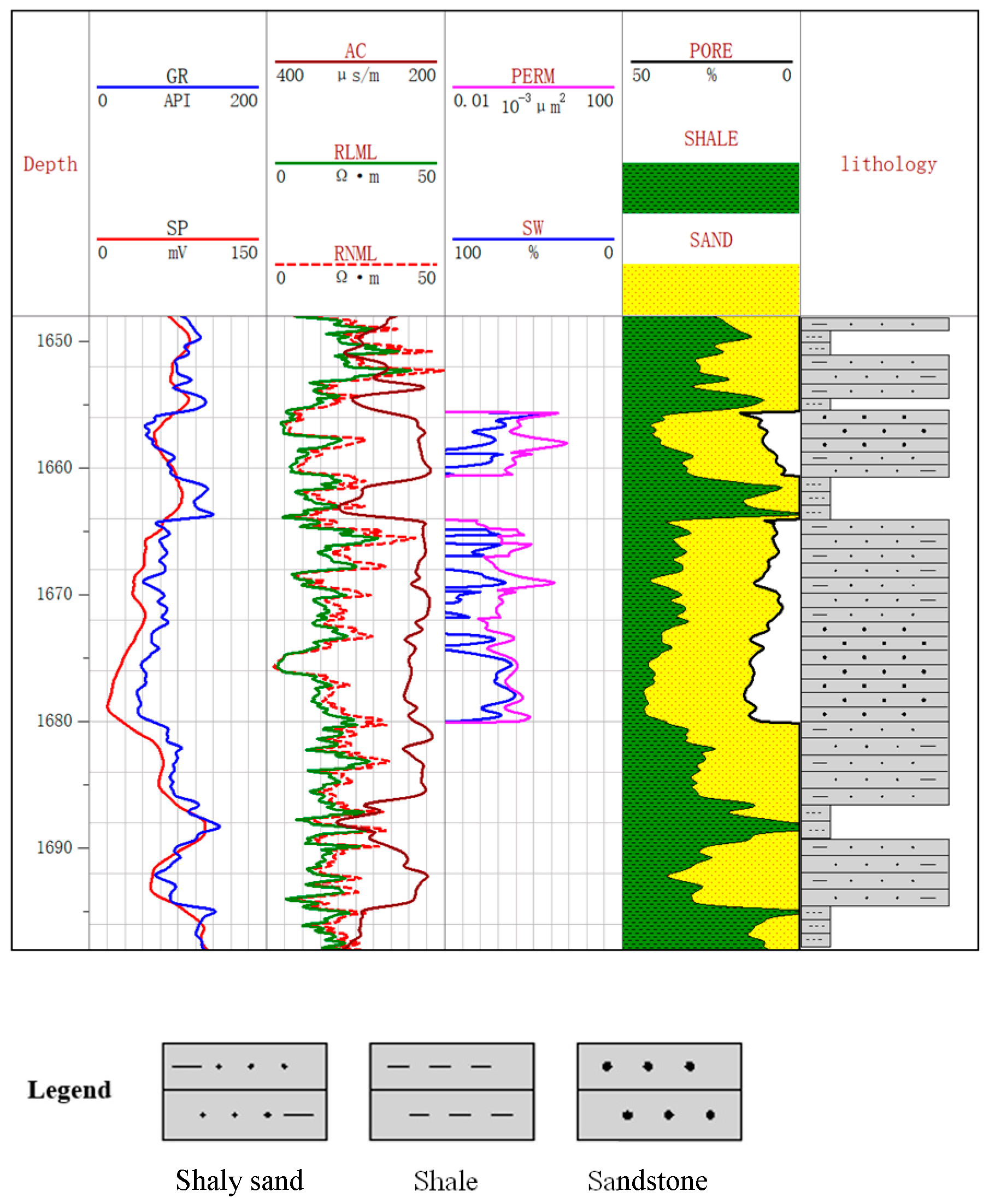
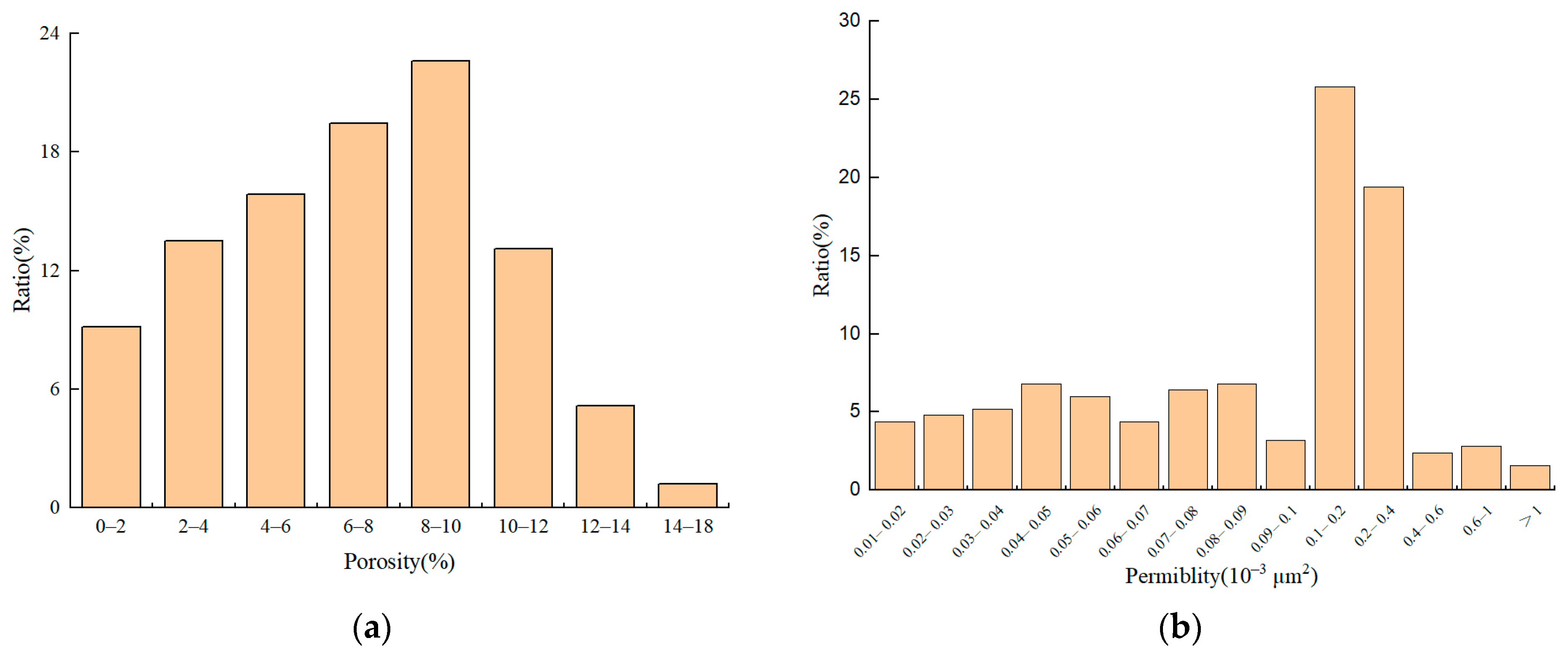
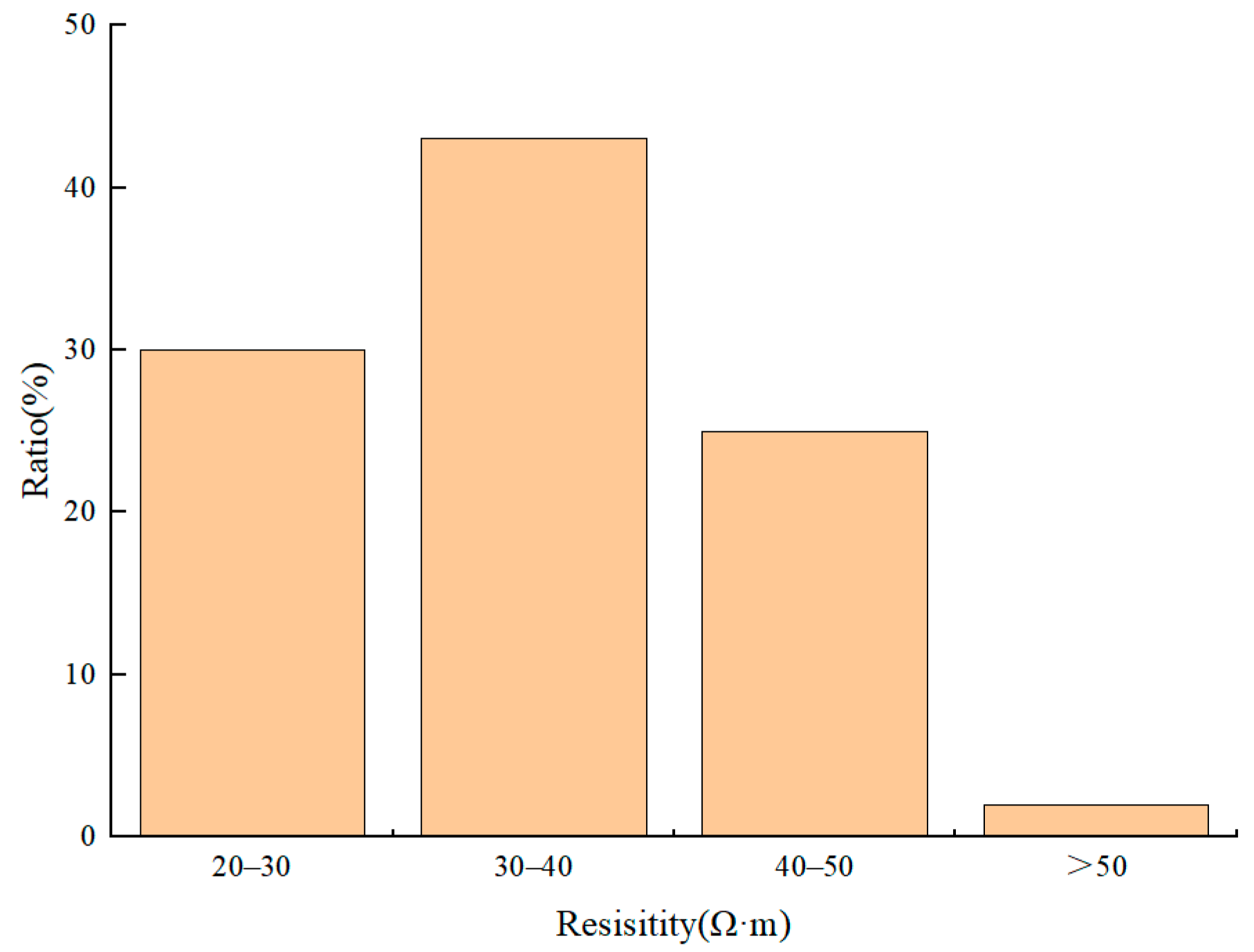

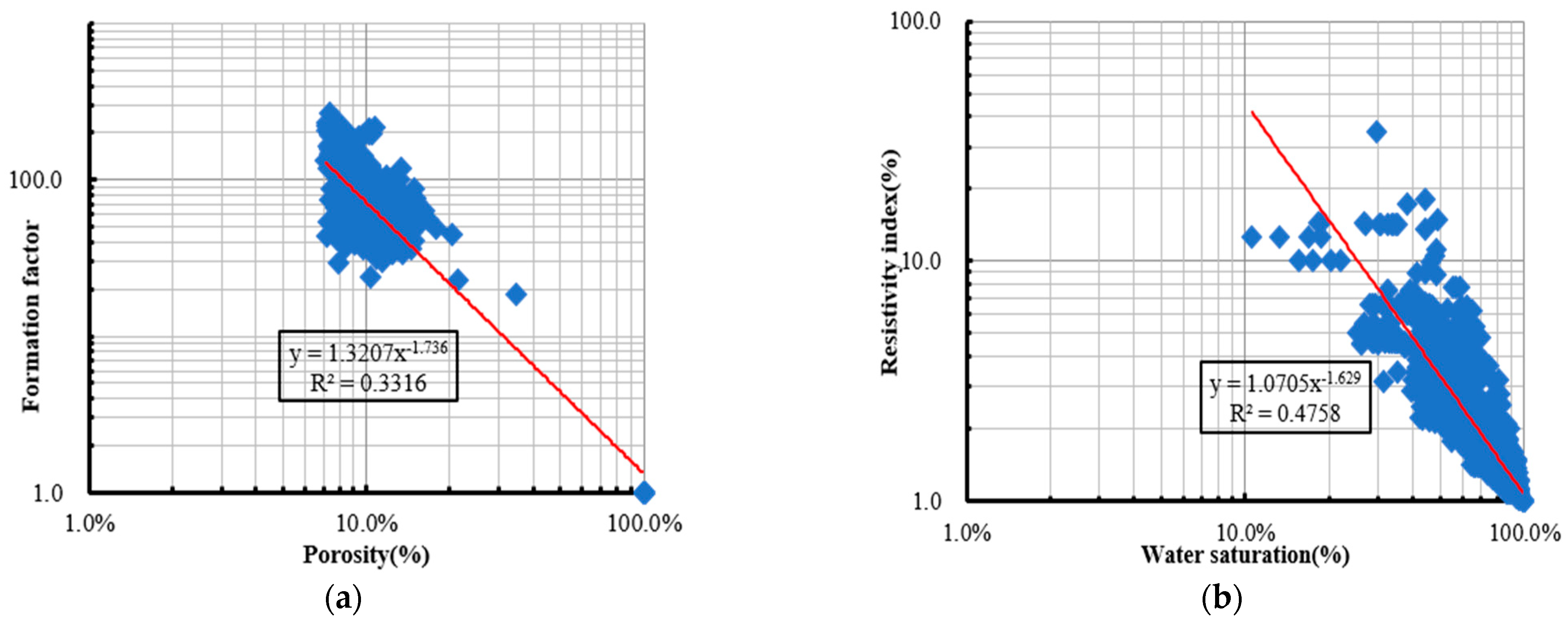
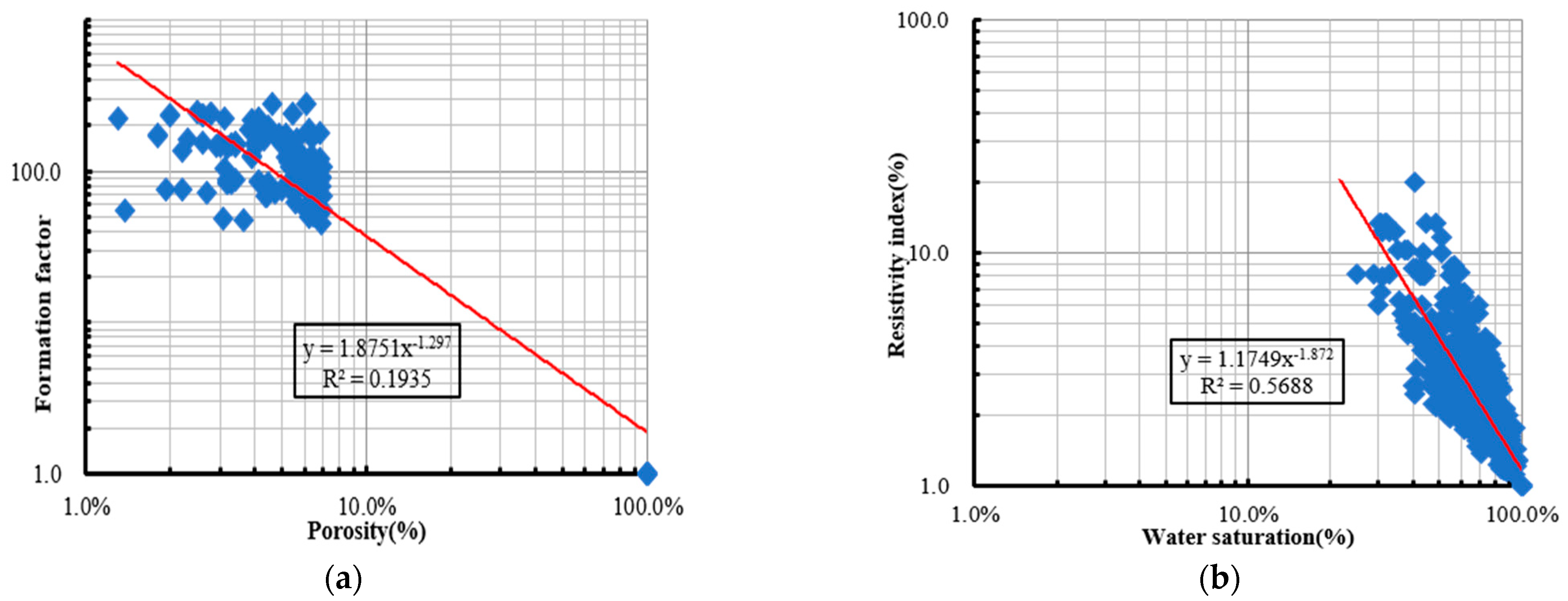
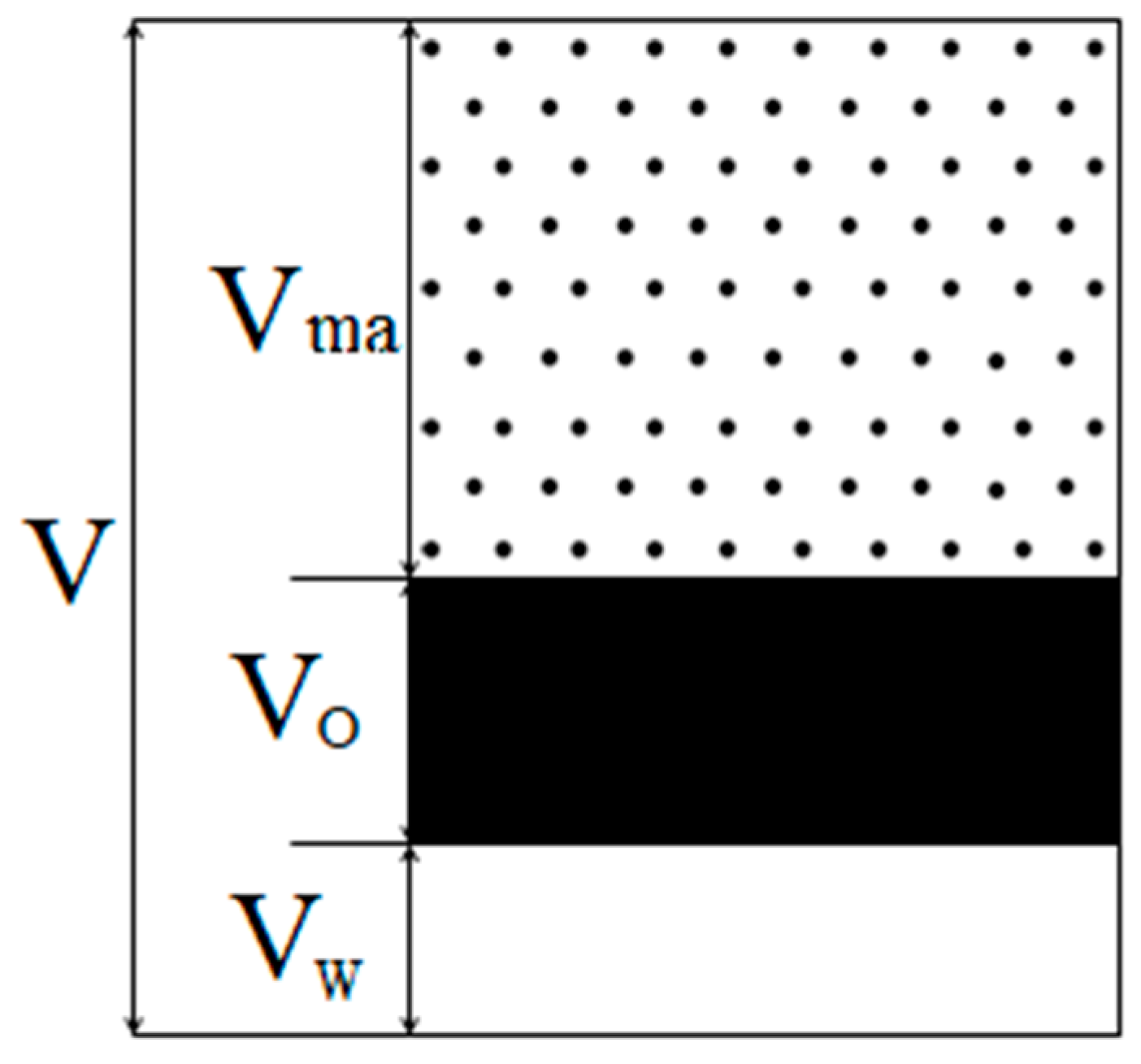
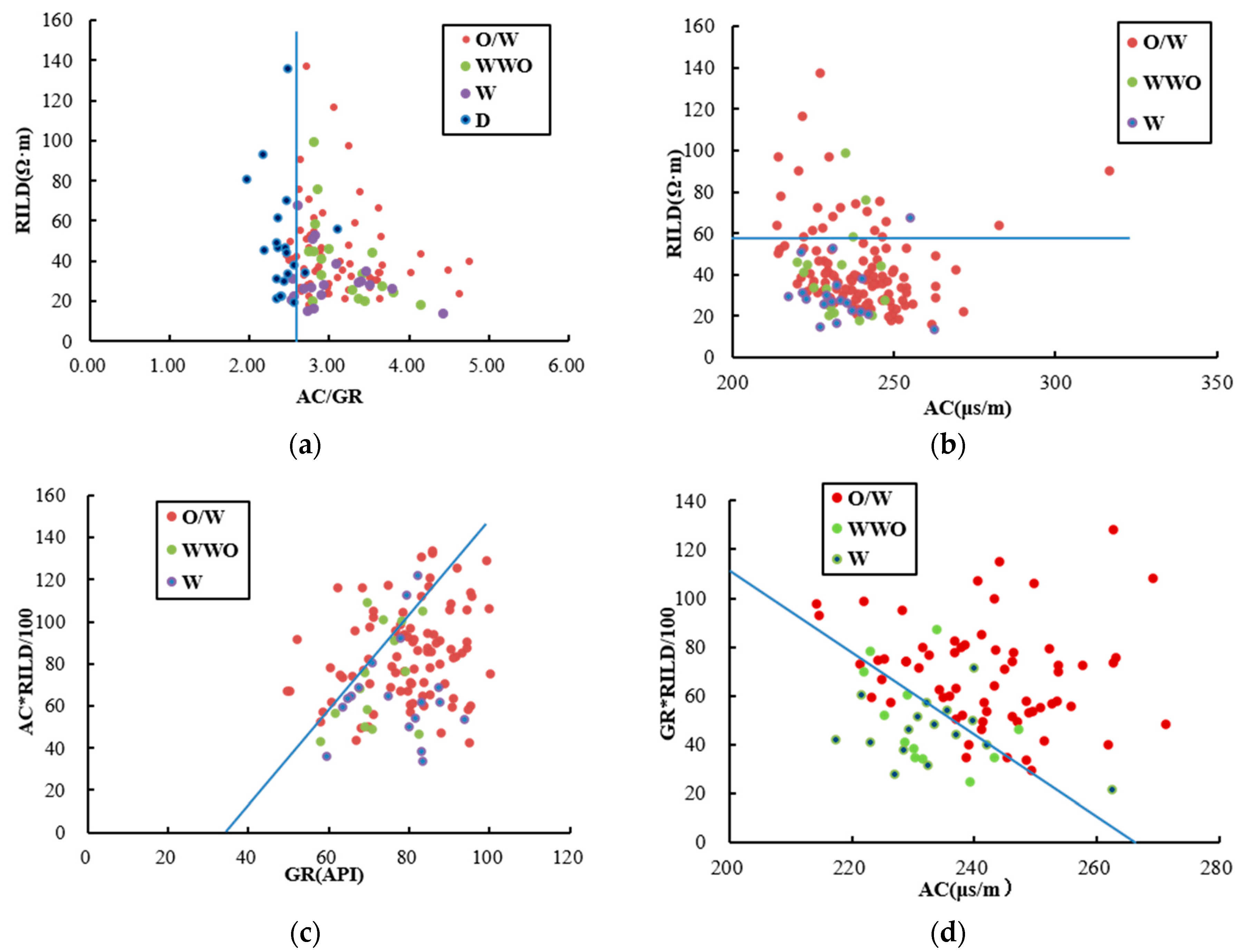

| Core Samples | Well | Depth | Terrigenous Debris | Thin-Section Porosity (%) | ||
|---|---|---|---|---|---|---|
| Quartz (%) | Feldspar (%) | Lithic (%) | ||||
| 1 | L96 | 1634.5 | 33.0 | 58.0 | 8.0 | 4 |
| 2 | L108 | 1507.3 | 31.0 | 57.0 | 6.0 | 8 |
| 3 | L108 | 1513.5 | 28.0 | 67.0 | 5.0 | 3 |
| 4 | L71 | 1479.7 | 25.0 | 66.0 | 8.0 | 2 |
| 5 | L120 | 1312.6 | 26.0 | 65.0 | 7.0 | 1 |
| 6 | L92 | 1677.7 | 28.0 | 67.0 | 4.0 | 2 |
| 7 | L92 | 1671.9 | 28.0 | 66.0 | 6.0 | 3 |
| 8 | L92 | 1751.4 | 20.0 | 72.0 | 8.0 | 1 |
| 9 | P198 | 1418.1 | 21.0 | 67.0 | 11.0 | 5 |
| 10 | P198 | 1531.5 | 29.0 | 61.0 | 10.0 | 4 |
| 11 | U113 | 1767 | 25.0 | 67.0 | 7.95 | 3 |
| 12 | P200 | 1817.4 | 27.8 | 63.3 | 8.89 | 1 |
| 13 | P200 | 1820.2 | 28.6 | 64.8 | 6.59 | 2 |
| 14 | U129 | 1745.7 | 25.6 | 64.4 | 10.0 | 5 |
| 15 | Q1 | 832.9 | 31.4 | 52.3 | 16.28 | 2 |
| 16 | X105 | 1081.3 | 27.2 | 64.1 | 8.7 | 5 |
| 17 | X105 | 1193.6 | 31.5 | 55.4 | 13.04 | 7 |
| 18 | S1040 | 1080.2 | 28.2 | 64.7 | 7.06 | 2 |
| 19 | S32 | 1471.5 | 21.7 | 72.3 | 6.0 | 8 |
| 20 | S32 | 1553 | 23.3 | 66.3 | 10.4 | 3 |
| Well | GR/ API | AC/ μs/m | AC/GR | RILD /Ω·m | RILM /Ω·m | LL8 /Ω·m | Explanation of Conclusions |
|---|---|---|---|---|---|---|---|
| L77 | 94.45 | 243.41 | 2.58 | 43.29 | 43.48 | 56.28 | O/W |
| L76 | 88.81 | 234.33 | 2.64 | 30.08 | 35.43 | 44.16 | O/W |
| L63 | 99.32 | 282.68 | 2.85 | 63.56 | 64.96 | 130.25 | O/W |
| L63 | 100.19 | 263.09 | 2.63 | 28.61 | 26.54 | 66.24 | O/W |
| L89 | 95.2 | 269.14 | 2.83 | 42.18 | 57.61 | 166 | O/W |
| L78 | 78.85 | 236.09 | 2.99 | 32.29 | 32.95 | 58.19 | O/W |
| L128 | 50.23 | 238.46 | 4.75 | 28.2 | 27.45 | 34.1 | O/W |
| L72 | 63.35 | 240.66 | 3.80 | 30.43 | 30.69 | 31.74 | O/W |
| L109 | 77.93 | 238 | 3.05 | 28.06 | 29.98 | 35.41 | O/W |
| L139 | 82.03 | 245 | 2.99 | 35.33 | 33.4 | 58.08 | O/W |
| L183 | 73.64 | 241.75 | 3.28 | 70.29 | 68.74 | 63.1 | O/W |
| L232 | 77.76 | 242.25 | 3.12 | 40.78 | 34.42 | 43.9 | O/W |
| L233 | 84.02 | 235.14 | 2.80 | 99.03 | 65.62 | 103.89 | WWO |
| L252 | 84.78 | 241.46 | 2.85 | 75.92 | 55.29 | 96.33 | WWO |
| L251 | 76.41 | 222 | 2.91 | 41.02 | 49.63 | 68.6 | WWO |
| L261 | 73.66 | 220.25 | 2.99 | 45.89 | 53.03 | 119.85 | WWO |
| L46 | 82.55 | 230.06 | 2.79 | 20.13 | 22.99 | 24.6 | WWO |
| L37 | 67.63 | 247.32 | 3.66 | 27.53 | 30.39 | 38.09 | WWO |
| L43 | 81.19 | 223.08 | 2.75 | 44.9 | 54.08 | 55.15 | WWO |
| L47 | 68.87 | 231.65 | 3.36 | 21.5 | 22.72 | 21.79 | WWO |
| L55 | 79.76 | 233.46 | 2.93 | 27.79 | 26.94 | 31.81 | W |
| L41 | 83.01 | 232.4 | 2.80 | 16.44 | 19.85 | 21.66 | W |
| L76 | 59.38 | 262.63 | 4.42 | 13.73 | 13.74 | 15.83 | W |
| L40 | 81.65 | 237 | 2.90 | 22.85 | 23.49 | 29.95 | W |
| L75 | 87.62 | 235.58 | 2.69 | 26.26 | 30.21 | 56.54 | W |
| L63 | 83.44 | 227.09 | 2.72 | 14.84 | 14.44 | 11.91 | W |
| L74 | 98.25 | 255.24 | 2.60 | 67.58 | 60.05 | 47.88 | W |
| L50 | 85.44 | 211.16 | 2.69 | 34.47 | 38.31 | 75.8 | D |
| L51 | 108.62 | 255.48 | 2.35 | 46.86 | 59.97 | 60.05 | D |
| P23 | 104.9 | 228.34 | 2.18 | 45.69 | 37.3 | 86.7 | D |
| L80 | 99 | 231.5 | 2.34 | 20.98 | 25.26 | 32.35 | D |
| Well | GR/ API | AC/ μs/m | RILD /Ω·m | POR /% | PERM /10−3 μm2 | SW /% | Oil Test (m3) | Explanation of Conclusions | Explanatory Model | ||||
|---|---|---|---|---|---|---|---|---|---|---|---|---|---|
| Oil | Water | Condition 1 | Condition 2 | Condition 3 | Result | ||||||||
| L108 | 62.29 | 238.09 | 22.04 | 13.37 | 0.36 | 58.96 | 2.04 | 19.86 | O/W | yes | O/W | ||
| L34 | 78.12 | 232.58 | 38.03 | 10.35 | 0.52 | 55.32 | 1 | 2.6 | O/W | yes | O/W | ||
| L80 | 75.29 | 246.61 | 58.46 | 14.03 | 1.47 | 30.72 | 1.83 | 1.84 | O/W | yes | O/W | ||
| L96 | 70.42 | 251.82 | 42.41 | 15.63 | 1.99 | 33.35 | 1.58 | 0.73 | O/W | yes | O/W | ||
| L110 | 78.22 | 253.54 | 33.64 | 15.95 | 0.95 | 37.64 | 0.87 | 1.78 | O/W | yes | O/W | ||
| L121 | 78.08 | 253.00 | 21.89 | 15.37 | 1.66 | 50.96 | 3 | 0.4 | O/W | yes | O/W | ||
| L128 | 53.95 | 244.83 | 32.30 | 15.60 | 1.19 | 39.50 | 2.7 | 5.63 | O/W | yes | O/W | ||
| L71 | 80.61 | 245.25 | 36.15 | 12.83 | 0.78 | 45.17 | 1 | 5 | O/W | yes | O/W | ||
| L92 | 64.25 | 231.17 | 13.27 | 11.36 | 0.16 | 95.10 | / | / | W | W | |||
| L120 | 84.34 | 222.03 | 116.27 | 6.73 | 8.53 | 22.55 | 0.49 | 1.83 | O/W | yes | O/W | ||
| P198 | 67.30 | 211.74 | 30.43 | 6.34 | 0.07 | 45.52 | 2 | 1 | O/W | yes | O/W | ||
| P200 | 89.89 | 217.87 | 19.29 | 7.07 | 0.77 | 56.00 | 1.6 | 7 | O/W | yes | O/W | ||
| P201 | 83.45 | 259.12 | 29.56 | 16.52 | 1.26 | 39.12 | 1.1 | 5.62 | O/W | yes | O/W | ||
| U113 | 77.12 | 253.07 | 43.14 | 15.83 | 1.76 | 32.56 | 5 | 8 | O/W | yes | O/W | ||
| U127 | 82.73 | 225.17 | 30.36 | 7.81 | 0.20 | 85.75 | 0 | 31.55 | W | yes | O/W | ||
| U129 | 62.46 | 221.44 | 52.30 | 9.01 | 1.08 | 52.78 | 1.3 | 1.8 | O/W | yes | O/W | ||
| Q1 | 85.89 | 216.10 | 25.89 | 6.66 | 0.28 | 60.15 | 1.4 | 2.88 | O/W | yes | O/W | ||
| X105 | 62.22 | 233.50 | 44.04 | 12.12 | 0.74 | 42.76 | 5.9 | 9 | O/W | yes | O/W | ||
| S1040 | 85.03 | 230.08 | 40.22 | 9.67 | 0.40 | 48.18 | 0.94 | 2.231 | O/W | yes | O/W | ||
| S32 | 80.59 | 243.50 | 20.69 | 13.27 | 0.36 | 51.72 | 3.67 | 5.403 | O/W | yes | O/W | ||
Disclaimer/Publisher’s Note: The statements, opinions and data contained in all publications are solely those of the individual author(s) and contributor(s) and not of MDPI and/or the editor(s). MDPI and/or the editor(s) disclaim responsibility for any injury to people or property resulting from any ideas, methods, instructions or products referred to in the content. |
© 2024 by the authors. Licensee MDPI, Basel, Switzerland. This article is an open access article distributed under the terms and conditions of the Creative Commons Attribution (CC BY) license (https://creativecommons.org/licenses/by/4.0/).
Share and Cite
Xu, B.; Wang, Z.; Song, T.; Zhang, S.; Peng, J.; Wang, T.; Chen, Y. Modeling of Quantitative Characterization Parameters and Identification of Fluid Properties in Tight Sandstone Reservoirs of the Ordos Basin. Processes 2024, 12, 278. https://doi.org/10.3390/pr12020278
Xu B, Wang Z, Song T, Zhang S, Peng J, Wang T, Chen Y. Modeling of Quantitative Characterization Parameters and Identification of Fluid Properties in Tight Sandstone Reservoirs of the Ordos Basin. Processes. 2024; 12(2):278. https://doi.org/10.3390/pr12020278
Chicago/Turabian StyleXu, Bo, Zhenhua Wang, Ting Song, Shuxia Zhang, Jiao Peng, Tong Wang, and Yatong Chen. 2024. "Modeling of Quantitative Characterization Parameters and Identification of Fluid Properties in Tight Sandstone Reservoirs of the Ordos Basin" Processes 12, no. 2: 278. https://doi.org/10.3390/pr12020278
APA StyleXu, B., Wang, Z., Song, T., Zhang, S., Peng, J., Wang, T., & Chen, Y. (2024). Modeling of Quantitative Characterization Parameters and Identification of Fluid Properties in Tight Sandstone Reservoirs of the Ordos Basin. Processes, 12(2), 278. https://doi.org/10.3390/pr12020278







